Low-Functioning Autism
An In-Depth Look at Low-Functioning Autism
Low-functioning autism, classified as Level 3 on the autism spectrum, represents the most severe end of the autism disorder spectrum. This article explores its characteristics, diagnosis, causes, treatment options, and the importance of respectful, individualized language to better understand and support individuals with this condition.
Characteristics and Symptoms of Low-Functioning Autism
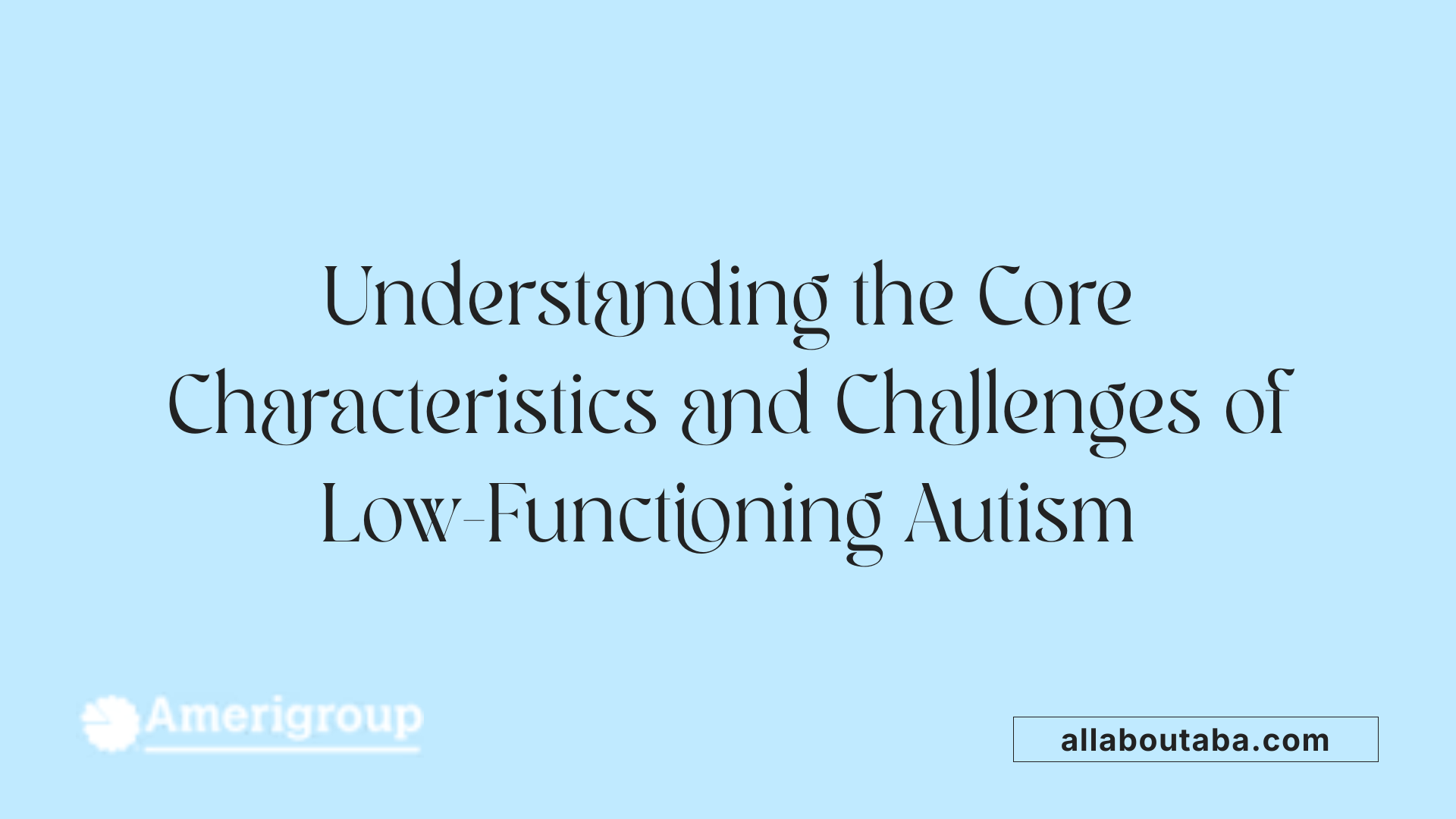
What are the characteristics and symptoms of low-functioning autism?
Children and adults classified as having low-functioning autism, generally aligning with Level 3 on the autism spectrum, face significant challenges across multiple areas of daily life. They often display profound difficulties with communication; many are nonverbal or have very limited speech capabilities. Their ability to understand social cues and engage in typical social interactions is severely impaired, making it hard for them to form or maintain relationships.
Repetitive behaviors are common, often involving stereotypic actions like hand-flapping, rocking, or other self-stimulatory movements. These behaviors tend to be inflexible and may intensify when routines are disrupted. Sensory processing issues are also prevalent; individuals might react intensely to touch, sound, or visual stimuli, which can cause distress or behavioral outbursts.
Supporting these observable symptoms are often underlying intellectual disabilities, which can include delays in motor skills, poor problem-solving abilities, and difficulty in performing daily tasks such as dressing, grooming, or eating independently. Co-occurring conditions like epilepsy, tuberous sclerosis, or Fragile X syndrome are frequently identified.
Early signs of low-functioning autism can include delayed walking, talking, or other motor milestones, as well as challenges in basic routines and daily activities. Behavioral issues like self-injury, agitation, or meltdowns may become apparent at young ages, sometimes as early as infancy.
Lifelong support is typically necessary for these individuals. Interventions such as applied behavioral analysis (ABA), speech therapy, occupational therapy, and sensory integration therapy aim to enhance communication, reduce problematic behaviors, and support daily functioning. While cognitive abilities vary, many individuals require assistance with even the most basic aspects of daily living.
This level of autism severity underscores the importance of early diagnosis and intervention, as tailored therapies can significantly improve quality of life. Despite their challenges, many individuals with low-functioning autism can make meaningful progress with consistent support and appropriate therapies.
Understanding Autism Spectrum Disorder (ASD) and Low-Functioning Autism
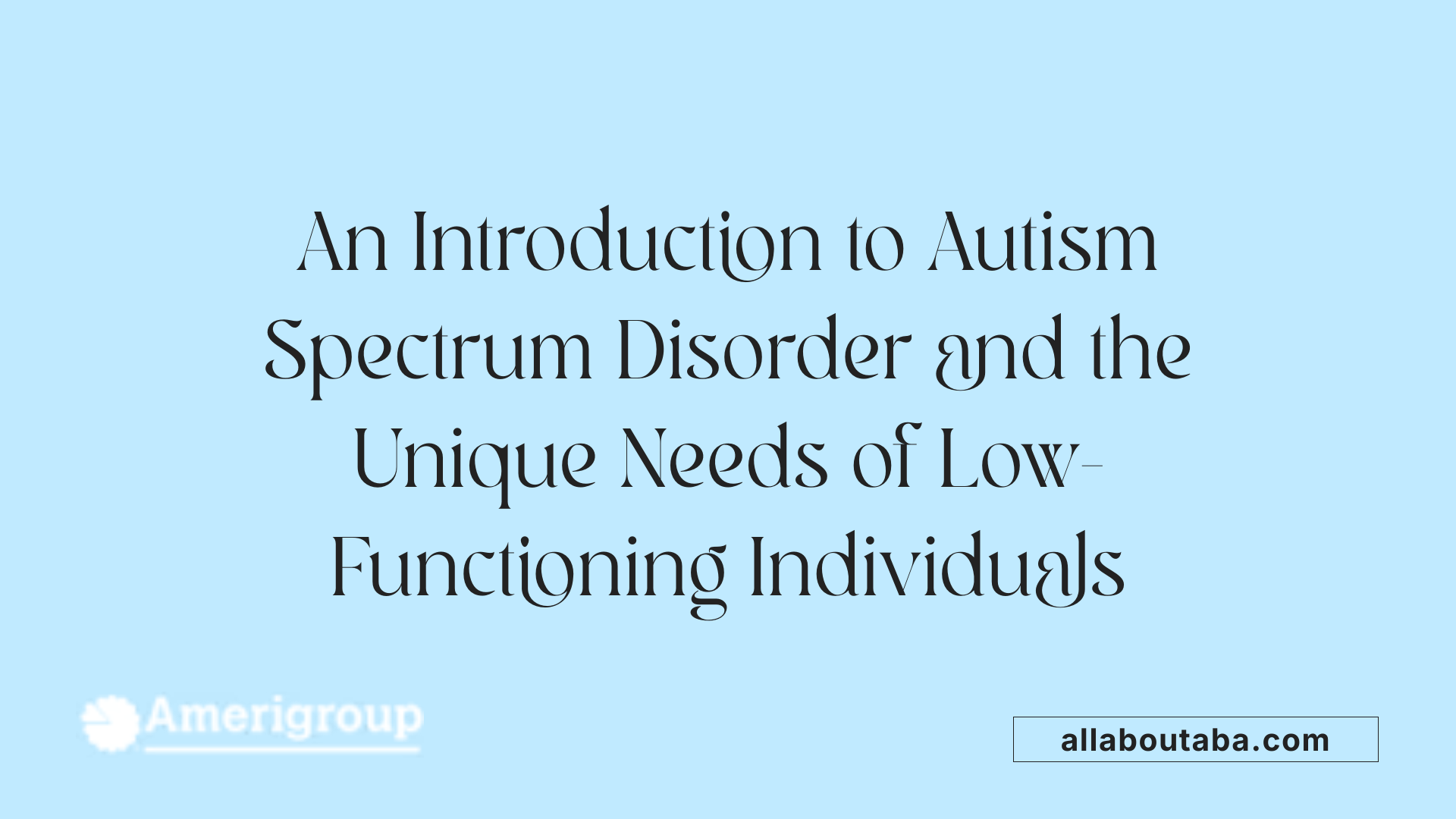
What is autism spectrum disorder (ASD), and what should be known about low-functioning autism within this context?
Autism spectrum disorder (ASD) is a neurodevelopmental condition that affects how a person communicates, interacts socially, and responds to sensory input. It encompasses a wide range of symptoms and severity levels, which is why it is called a spectrum.
Within this spectrum, low-functioning autism describes individuals who experience the most severe symptoms. These individuals often struggle significantly with communication, sometimes being nonverbal, and face substantial challenges in daily life. They may also have intellectual disabilities, with an IQ below 80, and require lifelong support.
Children and adults with low-functioning autism often display behaviors such as self-injury, repetitive movements, and difficulty adapting to changes. Safety is a major concern, as many cannot understand the consequences of their actions, leading to risks like wandering or self-harm.
Although there is no cure for ASD, early diagnosis and targeted interventions, including speech therapy, occupational therapy, and behavioral therapies like ABA, can greatly improve their quality of life. Tailored support helps these individuals manage their symptoms and develop skills that foster greater independence.
Overall, understanding the full scope of autism—including the severity and specific needs of individuals—is crucial for providing appropriate care and fostering inclusive environments.
Differences Between Low- and High-Functioning Autism
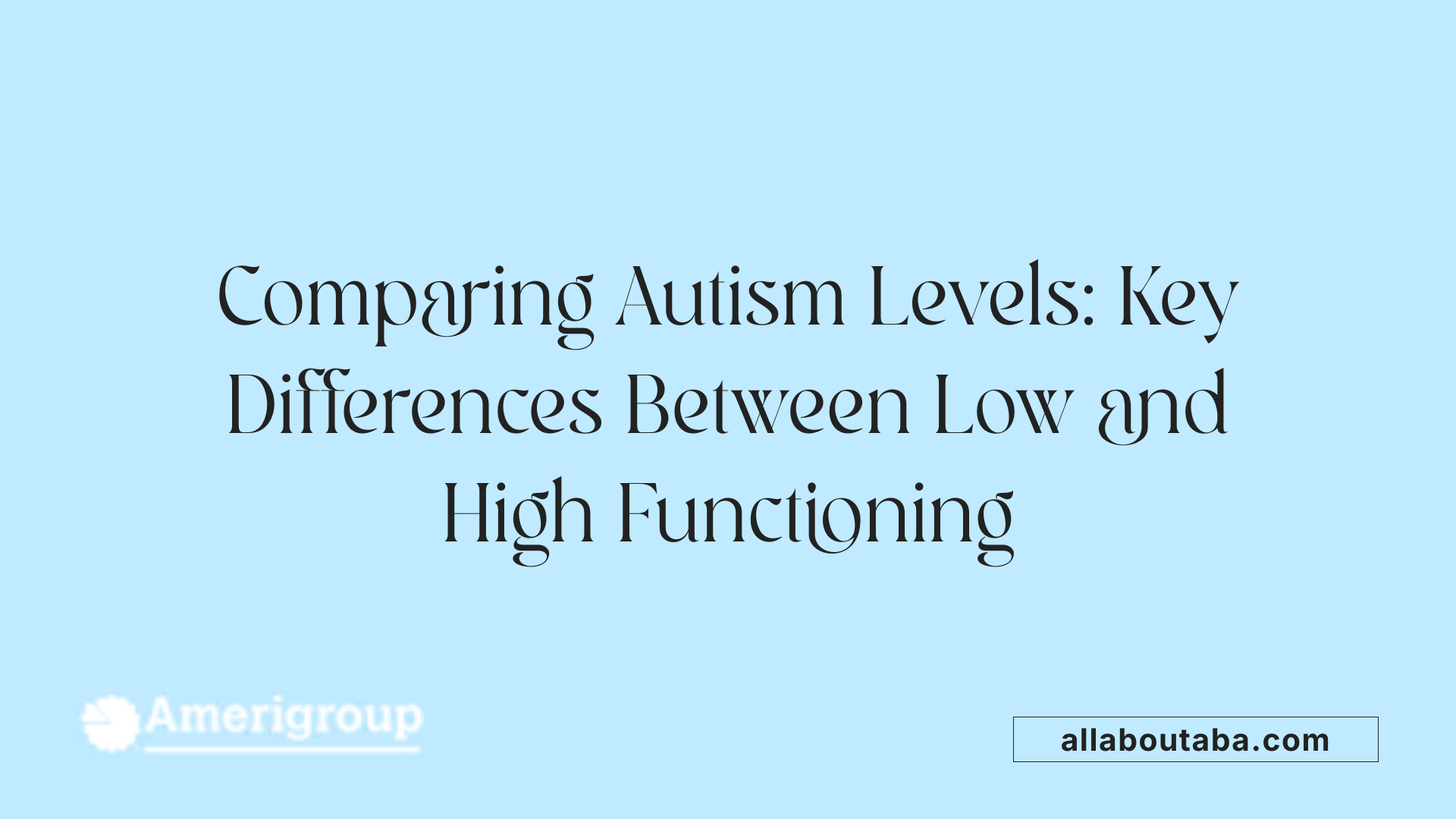
How does low-functioning autism differ from high-functioning autism?
Low-functioning autism, often associated with Level 3 on the autism severity spectrum, involves more pronounced challenges across various areas. These individuals usually experience significant difficulties with communication, often being nonverbal or having very limited speech. They also struggle with daily living skills, social interaction, and behavior regulation. Children and adults with low-functioning autism often do not reach typical developmental milestones, such as walking or speaking, on time. They may display behaviors like self-injury, meltdowns, and sensory sensitivities that can make daily life and safety management complex.
In contrast, high-functioning autism, generally classified as Level 1, features milder symptoms. These individuals usually have average or above-average IQs and can communicate verbally and function more independently in social and academic settings. They often display repetitive behaviors and routines but are capable of forming relationships, managing routines, and living somewhat independently with minimal support.
Support needs also differ markedly. Those with low-functioning autism generally require lifelong assistance, support in communication, behavior management, and daily activities. They may have accompanying intellectual disabilities that further limit independence. Conversely, individuals with high-functioning autism often need less intensive support and can participate more actively in educational and social activities.
It’s important to recognize that these labels are oversimplifications. While they help describe general levels of support and severity, each person's profile of strengths and challenges is unique. Modern diagnostic approaches, like the DSM-5, use severity levels instead of the outdated
Diagnosis and Assessment of Low-Functioning Autism
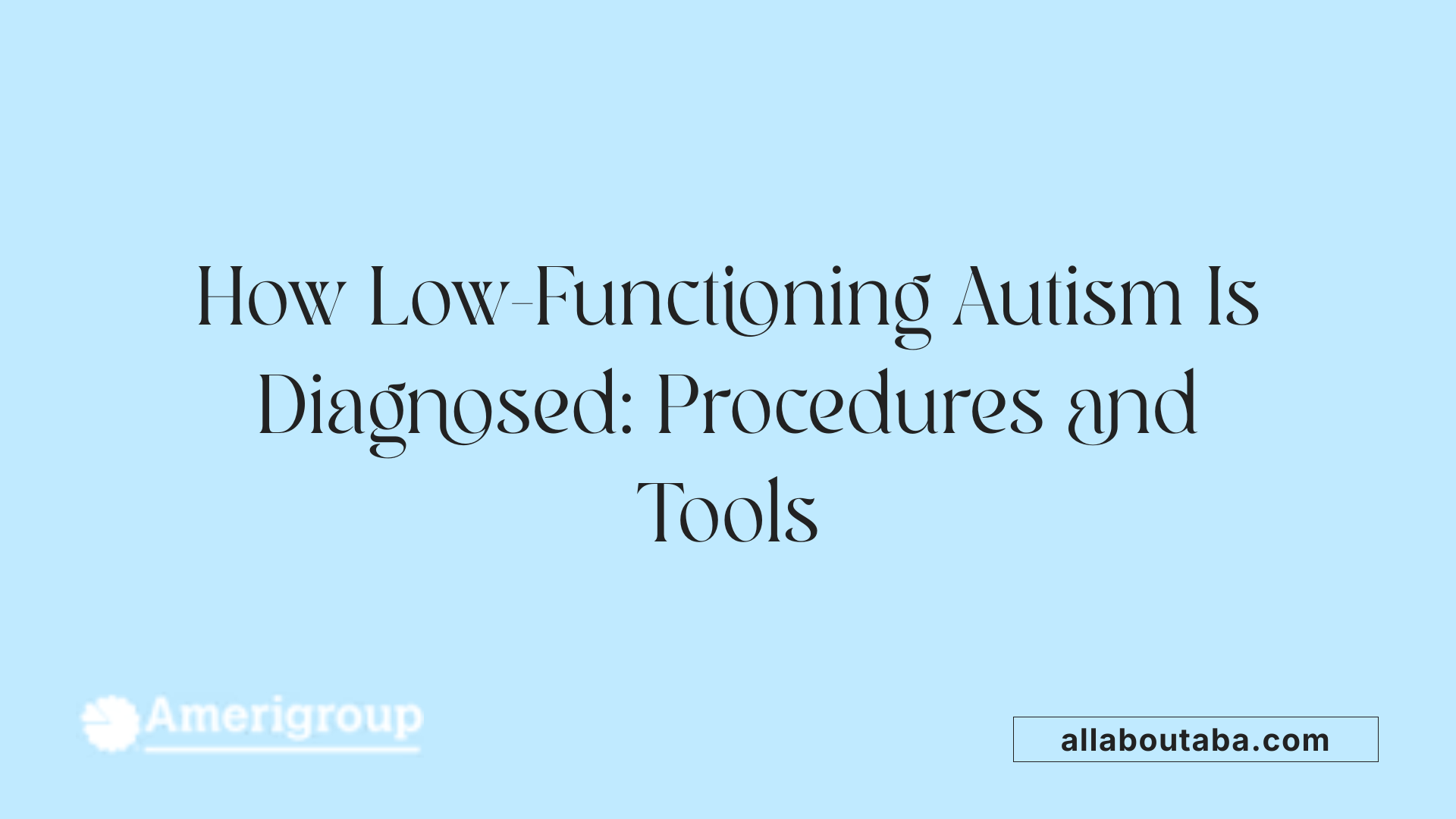 How is low-functioning autism diagnosed and assessed?
How is low-functioning autism diagnosed and assessed?
Diagnosing low-functioning autism involves a thorough and careful process conducted by specialists trained in neurodevelopmental assessments. These professionals typically include neurodevelopmental pediatricians, psychologists, or neurologists who analyze various aspects of a child's development.
The evaluation begins with collecting detailed developmental histories. This includes noting early milestones such as motor skills, speech development, and social interactions. Clinicians observe behaviors directly and look for hallmark signs of low-functioning autism, including severe communication challenges, repetitive behaviors, and significant difficulties in social engagement.
Standardized assessment tools are essential for an accurate diagnosis. The Autism Diagnostic Observation Schedule (ADOS) and the Autism Diagnostic Interview-Revised (ADI-R) are among the most widely used. ADOS involves structured and semi-structured tasks that assess social interaction, communication, and play behaviors. ADI-R gathers comprehensive information from caregivers about the individual's developmental history and current functioning.
Early screening views are vital for prompt intervention. Tools like the Modified Checklist for Autism in Toddlers (M-CHAT) help identify children at risk as early as 18 months. However, a formal diagnosis of low-functioning autism depends on more detailed clinical evaluations.
Because there are no specific biological or blood tests for autism, diagnosis relies heavily on behavioral data and clinician judgment. The assessment focuses on identifying deficits in social communication, restricted behaviors, and sensory issues. It also considers the level of support the individual needs, which is critical for planning interventions.
Support needs are assessed to determine appropriate therapies and services. This comprehensive approach ensures that each individual’s unique challenges and strengths are communicated clearly, facilitating tailored support plans that include behavioral therapies, communication aids, and educational accommodations.
In summary, diagnosing low-functioning autism is a multidisciplinary process rooted in behavioral observations, standardized tools, early screening, and support needs assessment—aiming to provide clarity and the best possible interventions for affected individuals.
Neurological and Biological Aspects Underlying Low-Functioning Autism
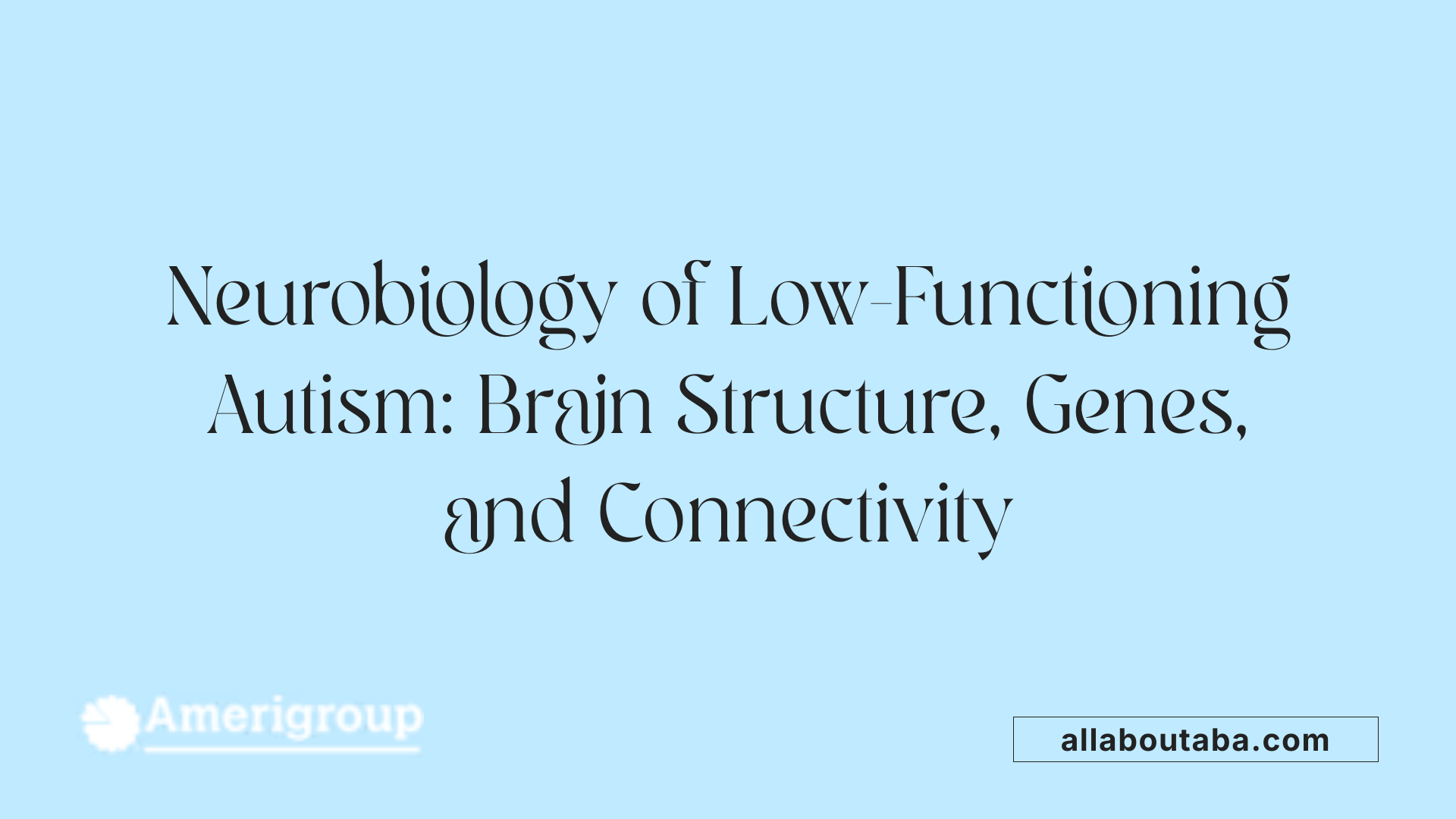
What are the causes and neurological aspects underlying low-functioning autism?
Low-functioning autism is rooted in complex neurodevelopmental differences, influenced by both genetic and environmental factors. These differences disrupt typical brain development and result in the severe symptoms observed in individuals classified under this level.
Neurologically, individuals with low-functioning autism often exhibit abnormal neural connectivity. Key regions involved include the cerebellum, fronto-striatal pathways, and the cingulate gyrus. Disruptions in these areas impair essential functions such as attention shifting, social information processing, and motor coordination.
Synaptic dysfunction plays a significant role, involving genes responsible for synapse formation and plasticity. Genes like neuroligins, neurexins, and SHANK are critical for establishing and maintaining effective neural communication. Variations or mutations in these genes lead to altered neural circuitry, contributing to the communication deficits and behavioral symptoms characteristic of low-functioning autism.
Comorbid neurological conditions frequently seen in these individuals include epilepsy, sleep disturbances, and motor impairments. These conditions stem from underlying abnormalities in neural circuits and neurochemical regulation, which further worsen functional limitations.
Research utilizing neuroimaging techniques like MRI reveals structural brain abnormalities, such as mega cisterna magna and hypoplastic corpus callosum, indicating atypical brain development. These abnormalities are more common among children with low-functioning autism compared to neurotypical populations or those with higher functioning autism.
Overall, the neurobiological landscape of low-functioning autism encompasses disrupted connectivity, genetic influences on synaptic formation, and structural brain irregularities. These factors collectively hinder social, communicative, and cognitive abilities, presenting significant challenges for affected individuals.
| Neurobiological Aspect | Description | Impact |
|---|---|---|
| Neural Connectivity | Abnormal connections in cerebellum, fronto-striatal pathways, cingulate gyrus | Impaired attention, social processing, motor skills |
| Genetic Factors | Variations in neuroligins, neurexins, SHANK genes | Disrupted synapse formation and plasticity |
| Structural Brain Abnormalities | Mega cisterna magna, hypoplastic corpus callosum | Developmental delays, motor and cognitive deficits |
| Associated Conditions | Epilepsy, sleep disorders, motor impairments | Further impact on daily functioning and development |
Understanding these neurobiological underpinnings highlights the importance of comprehensive assessments and tailored interventions to improve outcomes for individuals with low-functioning autism.
Treatment Options and Support Strategies
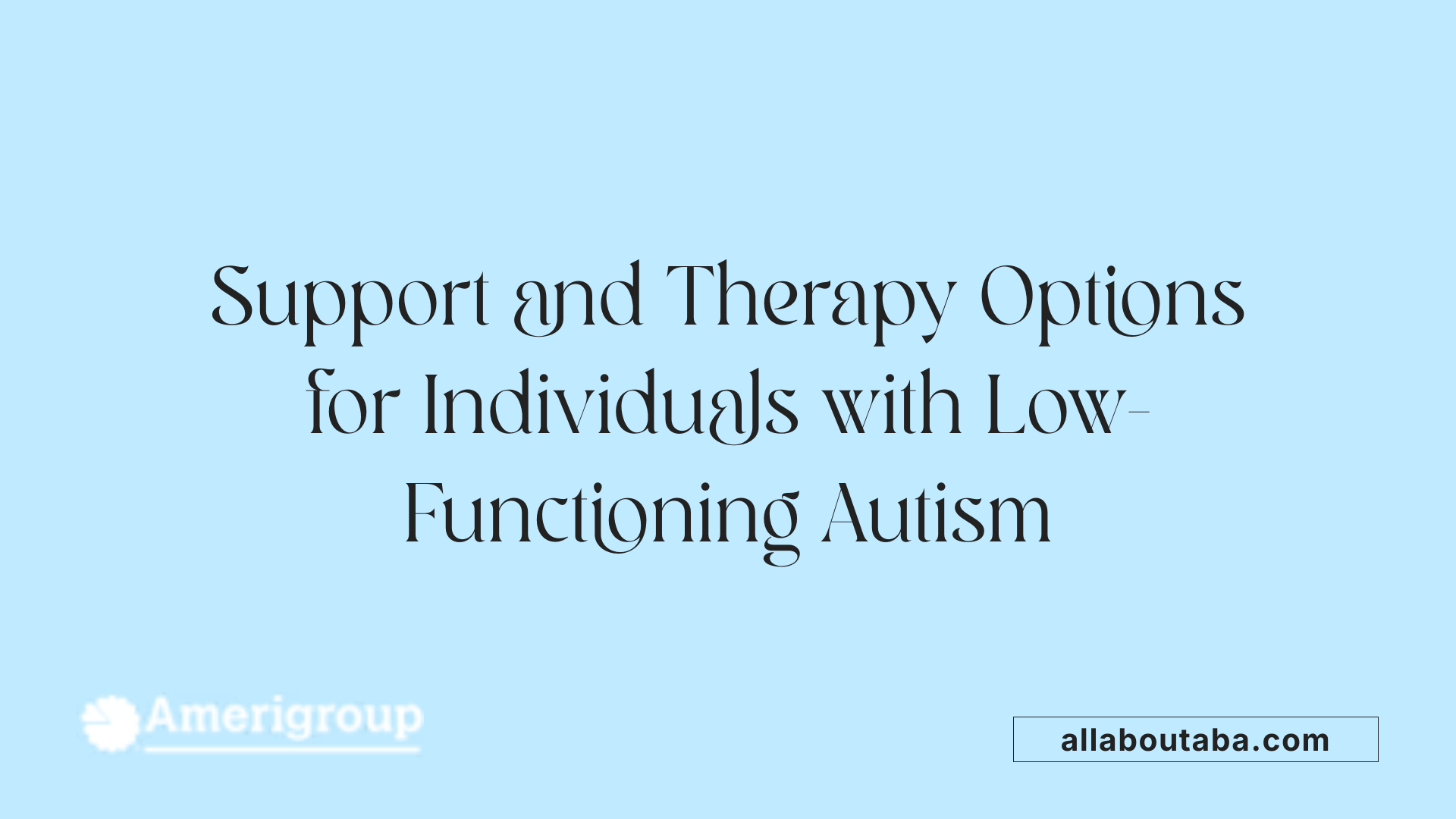 Individuals with low-functioning autism require a comprehensive and personalized approach to support their development and daily living needs. Early intervention is essential and often involves a variety of therapies tailored to the individual's specific challenges.
Individuals with low-functioning autism require a comprehensive and personalized approach to support their development and daily living needs. Early intervention is essential and often involves a variety of therapies tailored to the individual's specific challenges.
Behavioral therapies are considered the cornerstone of treatment. Applied Behavior Analysis (ABA) is widely regarded as the most effective, focusing on improving social, communication, and functional skills while reducing problematic behaviors through structured reinforcement techniques. Speech-language therapy is crucial, especially considering that many individuals with low-functioning autism are nonverbal or have limited speech. This therapy aims to enhance communication skills using augmentative and alternative communication (AAC) methods, such as picture exchange systems or communication devices.
Occupational therapy addresses sensory processing issues, motor skills, and daily routines. Children and adults often benefit from sensory integration therapy, which helps manage hypersensitivity to touch, sound, or visual stimuli, reducing distress and improving participation in activities.
In addition to therapy, structured educational programs like TEACCH and others are designed to provide predictable routines and visual supports, helping individuals understand expectations and reduce anxiety around transitions.
Support for co-occurring conditions such as epilepsy, tuberous sclerosis, or Fragile X syndrome involves appropriate medical management. Medications may be prescribed to control seizures, manage mood or behavioral issues, and address sleep disturbances.
Family and environmental support are fundamental. Caregivers play a critical role in daily routines, safety, and emotional support. Environment modifications, such as safety-proofing the home — especially to prevent wandering, head-banging, or self-injurious behaviors — are vital for safety. Community resources, respite care, and peer support networks can help families manage the challenges associated with low-functioning autism.
Person-centered care emphasizes respecting the individual’s dignity and preferences. It involves actively listening to the person and their family and avoiding stigmatizing labels or assumptions about their abilities. The goal is to foster independence, maximize quality of life, and support meaningful participation in community life.
Ultimately, a multidisciplinary team—including healthcare providers, therapists, educators, and families—collaborates to develop a tailored plan that promotes growth, safety, and well-being, recognizing that each person on the spectrum has unique needs and strengths.
The Outdated Nature of 'Funging' Labels and the Importance of Respectful Language

Why are the labels 'low-functioning' and 'high-functioning' considered outdated, and what terminology should be used instead?
The terms "high-functioning" and "low-functioning" autism are increasingly viewed as outdated and unhelpful. These labels originated in research from the 1980s, primarily based on IQ scores and observable support needs. However, they oversimplify the autism spectrum and can be harmful.
Using these labels can reinforce stereotypes, implying that abilities are fixed and definable by a single measure like intelligence. They may also create unnecessary hierarchies, suggesting that individuals with "high-functioning" autism are more capable or have fewer challenges than those labeled as "low-functioning."
Moreover, such labels can obscure the person's actual needs, strengths, and support requirements, leading to inadequate or misdirected support and misunderstanding.
Instead, modern approaches emphasize describing individuals based on specific traits, skills, and needs. For example, healthcare providers might specify an individual's communication style, sensory sensitivities, or behavioral patterns. This person-centered language respects personal dignity, avoids stigmatization, and provides clearer insights into how best to support each person.
The shift away from simplistic labels encourages recognizing the diversity within the autism spectrum as fluid and dynamic. Language that highlights individual strengths and challenges fosters understanding, promotes empowerment, and advocates for tailored support plans.
DSM-5 guidelines and severity levels
The DSM-5 categorizes autism spectrum disorder (ASD) into three severity levels based on support needs: Level 1 (requiring support), Level 2 (requiring substantial support), and Level 3 (requiring very substantial support). These levels focus on the individual's current functioning and support requirements, providing a more accurate, personalized framework than the traditional labels.
This system encourages clinicians and caregivers to assess support needs in real-life contexts rather than relying on fixed labels, promoting flexibility and personalized care. It also helps avoid stigmatizing connotations associated with "high" or "low" labels.
Person-centered language
Adopting respectful, person-centered language involves describing an individual’s unique abilities, challenges, and preferences. This approach emphasizes that each person is more than their diagnosis. For example, instead of saying "a low-functioning autistic," one might say, "an autistic individual with significant communication challenges and support needs."
This language fosters respect and emphasizes the person’s identity over their limitations. It encourages positive engagement and recognizes the potential for growth and development.
Reducing stigma and promoting dignity
Using respectful language reduces stigma by framing autism as a spectrum of diverse variations rather than a hierarchy of worth or capability. It supports the dignity of individuals by acknowledging their personhood and emphasizing their strengths.
Educational campaigns and professional training on appropriate language help shift societal attitudes, promoting inclusivity and acceptance. Support programs become more effective when communities recognize the complexity and individuality of each person on the spectrum.
By moving away from outdated labels and embracing respectful, person-centered language, we foster a more understanding and supportive environment tailored to each individual's actual needs and abilities.
Can Individuals with Low-Functioning Autism Improve Over Time?
Is it possible for individuals with low-functioning autism to improve over time?
Yes, individuals with low-functioning autism can experience improvements in their abilities and quality of life, especially when they receive early and tailored interventions. Early intervention programs often begin around ages 2 or 3 and focus on enhancing communication skills, social behaviors, and daily living abilities. These therapies, including Applied Behavioral Analysis (ABA), speech-language therapy, occupational therapy, and sensory integration therapy, are designed to address specific challenges and promote developmental progress.
Research shows that with consistent support, some individuals can develop essential skills that help them manage daily tasks, communicate more effectively, and participate more actively in community life. While complete independence might not be achievable for all, meaningful gains in adaptive functioning and reduced behavioral challenges are possible.
Factors such as family involvement, access to resources, community support, and personalized educational plans significantly influence outcomes. The progress made varies depending on individual circumstances, but ongoing therapy and support are crucial for fostering positive changes.
Why does early intervention matter?
Intervening early provides the brain with more plasticity—the ability to adapt and form new connections. This can lead to better acquisition of speech, social skills, and self-care routines compared to later interventions. Early programs are often multidisciplinary, involving specialists who work together to create comprehensive support plans, increasing the likelihood of positive developmental trajectories.
What factors influence whether an individual improves?
Several elements can affect progress in individuals with low-functioning autism:
- Severity of symptoms: The extent of communication and behavioral challenges can impact the rate and scope of development.
- Type and consistency of interventions: Regular, tailored therapies tend to produce better outcomes.
- Family participation: Active involvement and reinforcement at home support skill generalization.
- Environmental adjustments: Sensory-friendly environments and routine structures help reduce distress and improve learning.
- Health factors: Comorbid conditions like epilepsy or sensory processing disorder may influence development.
Examples of improvements
While each individual’s progress is unique, there are encouraging examples:
- Some children develop basic communication skills using augmentative and alternative communication (AAC) devices.
- Improvements in social interactions, such as reaching out for help or engaging in simple peer activities.
- Enhanced independence in daily routines like dressing, feeding, or personal hygiene.
- Reduction in problem behaviors such as head-banging, self-injury, or tantrums.
Ongoing support can lead to meaningful change
Even though challenges persist, the potential for growth is significant. Continuous, personalized interventions tailored to the individual’s needs can make a profound difference, sometimes allowing individuals with low-functioning autism to lead more connected and fulfilling lives.
Supporting Individuals with Low-Functioning Autism
Understanding the complexities and challenges faced by individuals with low-functioning autism is crucial for fostering empathy, appropriate support, and tailored interventions. Moving beyond outdated labels towards respectful, person-centered language helps reduce stigma and emphasizes each individual's unique strengths and needs. With early diagnosis, comprehensive therapies, and ongoing support, many individuals can achieve meaningful improvements and a higher quality of life. Society's role is to provide inclusive environments and dedicated resources to ensure that those with low-functioning autism are respected, supported, and empowered to reach their full potential.
References
- Low Functioning Autism: The Levels, Signs, Symptoms - AngelSense
- Low-Functioning Autism: All You Should Know
- Low Functioning Autism: Symptoms and Therapies
- Classic autism - Wikipedia
- Functioning Labels for Autism: Why They Are Outdated - Healthline
- Low-Functioning Autism | Definition, Symptoms & Concerns
- Classification of low-functioning and high-functioning autism using ...
- High functioning vs. low functioning autism: what is the difference?
- Low-Functioning Autism - Encyclopedia.pub
- Low-Functioning Autism and Nonsyndromic Intellectual Disability
Other articles
Recent articles

How Schools Can Support Autistic Students In Career Prep

Best Strategies For Autism-Friendly Event Planning

Understanding Noncontingent Reinforcement In Autism Behavior Plans

How Drama Therapy Benefits Autistic Individuals

Best Practices For Autism-Friendly Fitness And Recreation Centers

Best Ways To Promote Healthy Social Media Use For Autistic Teens

How To Help Autistic Children Cope With Public Speaking

Autism And Strategies For Managing Unexpected Changes

Best Podcasts About Autism For Parents And Educators

Autism And The Impact Of Seasonal Changes On Behavior

The Role Of Diet In Managing Co-Occurring Conditions With Autism

Sleep Challenges In Autism And Practical Solutions

Best Ways To Build Daily Routines For Autistic Children

Best Practices For Supporting Autistic Entrepreneurs

Autism And Strategies For Navigating Large Social Gatherings

Adaptive Sports And Recreational Activities For People With Autism

Autism And The Benefits Of Story-Based Learning Activities

Understanding The Role Of Play In Autism Development

Autism And The Impact Of Environmental Noise On Learning

How To Create Autism-Friendly Community Spaces

Autism And Chronic Health Conditions: What To Know

The Role Of Care Managers In Autism Life Planning

How To Teach Social Boundaries To Autistic Children

How Autistic Individuals Experience Empathy Differently

How To Support Autistic Employees In Remote Work Settings

Autism And The Relationship Between Motor Skills And Learning

How To Create Community Resource Guides For Autism Families

How To Teach Daily Living Skills To Autistic Teens

Autism And The Impact Of Mind-Body Practices On Stress Reduction

Autism And The Benefits Of Outdoor Group Activities

How To Create Autism-Friendly Sensory Paths In Schools

Best Practices For Autism-Friendly Park And Recreation Areas

Autism And Strategies For Reducing School Refusal

Supporting Autistic Individuals In Public Speaking

The Role Of Diet In Managing Autism Symptoms

The Benefits Of Gardening Clubs For Autism Social Development

How To Prepare Autistic Children For Dental Visits

Autism And Employment: Career Paths That Work

Best Practices For Autism-Friendly Hotels And Lodging

The Impact Of Screen Time On Autism Development

Autism Screening Tools For Early Childhood

The Role Of Physical Exercise In Autism Therapy

Best Strategies For Supporting Autistic College Students

The Role Of Technology In Autism Early Detection

Sensory-Friendly Classroom Design Ideas For Autistic Students

The Role Of Speech Therapy In Building Social Communication Skills

Best Strategies For Handling Autistic Burnout In Adults

Autism And The Importance Of Predictability In Routine

Autism And Peer Education: Teaching Acceptance In Schools

Best Practices For Sensory-Friendly Libraries And Reading Rooms

Self-Advocacy Skills For Autistic Adults

The Role Of Technology In Autism Peer Communication

Promoting Physical Activity In Children With Autism

How To Prepare Autistic Children For Medical Procedures

The Role Of Social Media In Autism Advocacy And Awareness

The Impact Of Sensory Rooms In Public Facilities For Autism

How To Create An Autism-Friendly Holiday Celebration

Best Practices For Inclusive Education For Autistic Students

Autism And Mental Health: Recognizing Signs Of Distress

Best Practices For Sensory-Friendly Waiting Rooms

The Role Of Teachers In Early Autism Red Flag Identification

Autism-Friendly Housing Design Features

Autism-Friendly Housing Design Features

How Environmental Modifications Improve Autism Outcomes

Autism And Technology-Based Learning Tools

Supporting Autistic Children Through Changes In Routine

The Link Between Autism And Working Memory Challenges

Best Practices For Autism-Friendly Cooking Classes

Autism And The Benefits Of Structured Music Lessons

Best Books To Teach Kids About Autism Acceptance

Sensory Diets And Their Benefits For Autism Management

How To Prepare Autistic Teens For Driver’s Education

How To Teach Autistic Teens About Healthy Relationships

The Role Of Visual Prompts In Building Daily Habits For Autism

Addressing Sleep Regression In Children With Autism

Understanding Social Stories And How They Help Autistic Children

Navigating Insurance Coverage For Autism Therapy Services

How To Prepare Autistic Adults For Independent Travel

Supporting Autistic Individuals In Volunteer Work

How Mindfulness Practices Can Support Autism Well-Being

Understanding Hyperfocus And Special Interests In Autism

Understanding Stimming As A Self-Regulation Tool

Sensory-Based Interventions For Autism At Home

Best Ways To Introduce Self-Advocacy In Autistic Teens

Best Ways To Support Autistic Employees In Customer Service Roles

Best Practices For Autism-Friendly Volunteer Programs

Autism And The Benefits Of Sensory Play For Emotional Growth

Autism And Strategies For Building Peer Relationships

Understanding How Autism Affects Memory Processing

Autism And Strategies For Building Coping Skills In Teens

The Role Of Parent Training In Autism Intervention Programs

Autism-Friendly Workplace Accommodations

Using Visual Timers For Autism Time Management

What Is ABA Therapy?

Autism and Sleep

Do Plastic Toys Cause Autism?

Autism Facial Expressions

Autism and Motor Skills

Which Parent Carries The Autism Gene?

Autism Symbols & Colors
We’re All About You, Your Family, and Your Child

